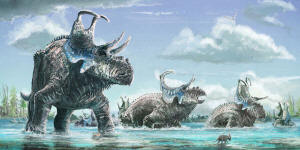|
Dinosaur duo sported exotic spikes and
horns
 Send a link to a friend
Send a link to a friend
[May 19, 2016]
By Will Dunham
WASHINGTON (Reuters) - Two newly
discovered dinosaurs unearthed in the western U.S. states of Montana and
Utah are illustrating the exotic appearance some of these beasts
developed, with fanciful horns and spikes, toward the end of their reign
on Earth.
|

Machairoceratops is shown in this artist depiction courtesy of Pat
O'Connor. Pat O'Connor/Courtesy of Ohio University/Handout via REUTERS |
|
 Scientists on Wednesday announced the discovery of fossils of two
species that provide new insights into an important group of
truck-sized, four-legged, plant-munching, horned dinosaurs that
roamed the landscape late in the Cretaceous Period. Scientists on Wednesday announced the discovery of fossils of two
species that provide new insights into an important group of
truck-sized, four-legged, plant-munching, horned dinosaurs that
roamed the landscape late in the Cretaceous Period.
Both dinosaurs were members of a group called ceratopsians that
included the well-known Triceratops, typically possessing
parrot-like beaks to crop low-growing herbs and shrubs, a bony neck
shield, or frill, and forward-pointing facial horns.
Fossils of Machairoceratops cronusi, which lived about 77 million
years ago, were found in Utah's Grand Staircase-Escalante National
Monument.
 Machairoceratops, up to 26 feet (8 meters) long, had two large,
forward-curving spikes coming out of the back of its shield, each
marked by a peculiar groove extending from the base of the spike to
the tip, Ohio University paleontologist Eric Lund said.
Machairoceratops also had two horns over its eyes and probably one
over its nose, although the incomplete fossils did not show that.
Fossils of Spiclypeus shipporum, which lived about 76 million years
ago, were discovered near the town of Winifred, Montana.
Spiclypeus, about 15 feet (4.5 meters) long, boasted brow horns
sticking out sideways rather than pointing forward, paleontologist
Jordan Mallon of the Canadian Museum of Nature in Ottawa said. It
had spikes at the back of its frill that pointed in different
directions: some curling forward and others projecting outward,
Mallon said.
"We think the horns and frills were probably used for display of
some sort, either for sexual or species recognition," Mallon said.
[to top of second column] |

This Spiclypeus individual was dubbed "Judith" because the fossils
came from the Judith River rock formation. Judith apparently lived a
painful life. The upper bone in its left front leg bore signs of
disease: arthritis near the shoulder joint and a hole near the elbow
caused by a bone infection.
"I think Spiclypeus wins top prize for being the most aesthetically
pleasing horned dinosaur, but that's my bias talking," Mallon said.
"I think a visitor to the Late Cretaceous would have been
immediately intimidated by standing in the shadow of Judith's spiky
skull, but then overcome with sympathy after noting the animal
ambling about painfully on only three legs."
The research was published in the journal PLOS ONE.
(Reporting by Will Dunham; Editing by Sandra Maler)
[© 2016 Thomson Reuters. All rights
reserved.]
Copyright 2016 Reuters. All rights reserved. This material may not be published,
broadcast, rewritten or redistributed.
 |